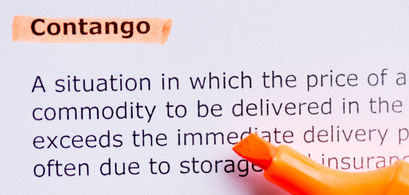Definition
The financial investing term contango refers to a market condition where the current price of a futures contract is higher than the anticipated spot price at maturity. Contango is considered a normal market condition, while an unusual form of this relationship is known as backwardation.
Explanation
As a futures contract moves closer to the expiry date, the price of the contract will converge to the spot price. If this did not happen, the futures price would be different than the spot price and arbitrage would be possible. Under normal market conditions, the price of a futures contract will decrease over time, and this downward sloping plot is referred to as contango.
The current price of a futures contract for a market "in contango" will be higher than the expected spot price on the contract's expiration date. Investors that hold the contract to maturity (are long in their position) will see the value of their contract decrease over time as the future's contract converges to the spot price.
As the illustration below demonstrates, the investor is paying a premium to hold onto this asset. This premium is referred to as negative basis. Investors will pay this premium to receive an asset in the future if this premium is less than the cost to buy the asset today (including carrying costs) and store the asset.
Contango versus Inverted Yield Curve
Contango is sometimes confused with an inverted yield curve; since both exhibit the same downward sloping curve. A yield curve is a plot of interest rates for debt of various maturities at a single point in time, while contango plots the price of a single futures contract over time.
Example
The following illustration demonstrates a futures contract "in contango."
Related Terms




